Landslide Identification in the Yuanjiang Basin of Northwestern Hunan, China, Using Multi-Temporal Polarimetric InSAR with Comparison to Single-Polarization Results
Abstract
1. Introduction
2. Study Area and Datasets
2.1. Study Area
2.2. Experimental Data
3. Methodology
3.1. Single-Polarization MT-InSAR Method
3.2. MT-PolInSAR Method
3.2.1. Homogeneous Pixel Identification
3.2.2. PS Target Refinement
3.2.3. Multi-Polarization Phase Optimization
4. Results
4.1. Average LOS Deformation Rate in the Study Area
4.2. Time-Series Deformation Analysis of Potential Hazard Sites
5. Discussion
5.1. Interferometric Phase Quality
5.2. Density of Monitoring Points
5.3. Operational Considerations for Full-Polarization InSAR
6. Conclusions
Author Contributions
Funding
Data Availability Statement
Acknowledgments
Conflicts of Interest
References
- Hu, J.; Li, Z.W.; Sun, Q.; Zhu, J.J.; Ding, X.L. Three-Dimensional Surface Displacements from Insar and GPS Measurements with Variance Component Estimation. IEEE Geosci. Remote Sens. Lett. 2012, 9, 754–758. [Google Scholar] [CrossRef]
- Sun, Q.; Zhang, L.; Ding, X.L.; Hu, J.; Li, Z.W.; Zhu, J.J. Slope Deformation Prior to Zhouqu, China Landslide from InSAR Time Series Analysis. Remote Sens. Environ. 2015, 156, 45–57. [Google Scholar] [CrossRef]
- Zhao, R.; Li, Z.-W.; Feng, G.-C.; Wang, Q.-J.; Hu, J. Monitoring Surface Deformation over Permafrost with an Improved SBAS-InSAR Algorithm: With Emphasis on Climatic Factors Modeling. Remote Sens. Environ. 2016, 184, 276–287. [Google Scholar] [CrossRef]
- Minh, D.H.T.; Hanssen, R.; Rocca, F. Radar Interferometry: 20 Years of Development in Time Series Techniques and Future Perspectives. Remote Sens. 2020, 12, 1364. [Google Scholar] [CrossRef]
- Ferretti, A.; Prati, C.; Rocca, F. Nonlinear Subsidence Rate Estimation Using Permanent Scatterers in Differential SAR Interferometry. IEEE Trans. Geosci. Remote Sens. 2000, 38, 2202–2212. [Google Scholar] [CrossRef]
- Ferretti, A.; Prati, C.; Rocca, F. Permanent Scatterers in SAR Interferometry. IEEE Trans. Geosci. Remote Sens. 2001, 39, 8–20. [Google Scholar] [CrossRef]
- Berardino, P.; Fornaro, G.; Lanari, R.; Sansosti, E. A New Algorithm for Surface Deformation Monitoring Based on Small Baseline Differential SAR Interferograms. IEEE Trans. Geosci. Remote Sens. 2002, 40, 2375–2383. [Google Scholar] [CrossRef]
- Ferretti, A.; Fumagalli, A.; Novali, F.; Prati, C.; Rocca, F.; Rucci, A. A New Algorithm for Processing Interferometric Data-Stacks: SqueeSAR. IEEE Trans. Geosci. Remote Sens. 2011, 49, 3460–3470. [Google Scholar] [CrossRef]
- Bui, L.K.; Featherstone, W.E.; Filmer, M.S. Disruptive Influences of Residual Noise, Network Configuration and Data Gaps on InSAR-Derived Land Motion Rates Using the SBAS Technique. Remote Sens. Environ. 2020, 247, 111941. [Google Scholar] [CrossRef]
- Lee, J.C.; Shirzaei, M. Novel Algorithms for Pair and Pixel Selection and Atmospheric Error Correction in Multitemporal InSAR. Remote Sens. Environ. 2023, 286, 113447. [Google Scholar] [CrossRef]
- Danisor, C.; Pauciullo, A.; Reale, D.; Fornaro, G. Detection of Distributed Scatterers in Multitemporal SAR Interferometry: A Comparison between Caesar and Squeesar Detectors. IEEE Trans. Geosci. Remote Sens. 2023, 61, 5220415. [Google Scholar] [CrossRef]
- Sowter, A.; Bateson, L.; Strange, P.; Ambrose, K.; Fifiksyafiudin, M. Dinsar Estimation of Land Motion Using Intermittent Coherence with Application to the South Derbyshire and Leicestershire Coalfields. Remote Sens. Lett. 2013, 4, 979–987. [Google Scholar] [CrossRef]
- Zhang, B.; Chang, L.; Stein, A. A Model-Backfeed Deformation Estimation Method for Revealing 20-Year Surface Dynamics of the Groningen Gas Field Using Multi-Platform SAR Imagery. Int. J. Appl. Earth Obs. Geoinf. 2022, 111, 102847. [Google Scholar] [CrossRef]
- Hu, J.; Ge, Q.; Liu, J.; Yang, W.; Du, Z.; He, L. Constructing Adaptive Deformation Models for Estimating Dem Error in Sbas-Insar Based on Hypothesis Testing. Remote Sens. 2021, 13, 2006. [Google Scholar] [CrossRef]
- Liu, Y.; Zhao, C.; Zhang, Q.; Lu, Z.; Zhang, J. A Constrained Small Baseline Subsets (CSBAS) InSAR Technique for Multiple Subsets. Eur. J. Remote Sens. 2020, 53, 14–26. [Google Scholar] [CrossRef]
- Zheng, Y.; Zebker, H.; Michaelides, R. A New Decorrelation Phase Covariance Model for Noise Reduction in Unwrapped Interferometric Phase Stacks. IEEE Trans. Geosci. Remote Sens. 2021, 59, 10126–10135. [Google Scholar] [CrossRef]
- Fornaro, G.; Verde, S.; Reale, D.; Pauciullo, A. CAESAR: An Approach Based on Covariance Matrix Decomposition to Improve Multibaseline-Multitemporal Interferometric SAR Processing. IEEE Trans. Geosci. Remote Sens. 2015, 53, 2050–2065. [Google Scholar] [CrossRef]
- Cao, N.; Lee, H.; Jung, H.C. A Phase-Decomposition-Based PSInSAR Processing Method. IEEE Trans. Geosci. Remote Sens. 2016, 54, 1074–1090. [Google Scholar] [CrossRef]
- Samiei-Esfahany, S.; Martins, J.E.; Van Leijen, F.; Hanssen, R.F. Phase Estimation for Distributed Scatterers in InSAR Stacks Using Integer Least Squares Estimation. IEEE Trans. Geosci. Remote Sens. 2016, 54, 5671–5687. [Google Scholar] [CrossRef]
- Narayan, A.B.; Tiwari, A.; Dwivedi, R.; Dikshit, O. A Novel Measure for Categorization and Optimal Phase History Retrieval of Distributed Scatterers for InSAR Applications. IEEE Trans. Geosci. Remote Sens. 2018, 56, 5843–5849. [Google Scholar] [CrossRef]
- Ansari, H.; De Zan, F.; Bamler, R. Efficient Phase Estimation for Interferogram Stacks. IEEE Trans. Geosci. Remote Sens. 2018, 56, 4109–4125. [Google Scholar] [CrossRef]
- Navarro-Sanchez, V.D.; Lopez-Sanchez, J.M.; Vicente-Guijalba, F. A Contribution of Polarimetry to Satellite Differential SAR Interferometry: Increasing the Number of Pixel Candidates. IEEE Geosci. Remote Sens. Lett. 2010, 7, 276–280. [Google Scholar] [CrossRef]
- Iglesias, R.; Monells, D.; Lopez-Martinez, C.; Mallorqui, J.J.; Fabregas, X.; Aguasca, A. Polarimetric Optimization of Temporal Sublook Coherence for DInSAR Applications. IEEE Geosci. Remote Sens. Lett. 2015, 12, 87–91. [Google Scholar] [CrossRef]
- Sadeghi, Z.; Valadan Zoej, M.J.; Hooper, A.; Lopez-Sanchez, J.M. A New Polarimetric Persistent Scatterer Interferometry Method Using Temporal Coherence Optimization. IEEE Trans. Geosci. Remote Sens. 2018, 56, 6547–6555. [Google Scholar] [CrossRef]
- Zhao, F.; Mallorqui, J.J. Coherency Matrix Decomposition-Based Polarimetric Persistent Scatterer Interferometry. IEEE Trans. Geosci. Remote Sens. 2019, 57, 7819–7831. [Google Scholar] [CrossRef]
- Zhao, F.; Mallorqui, J.J.; Lopez-Sanchez, J.M. Impact of SAR Image Resolution on Polarimetric Persistent Scatterer Interferometry with Amplitude Dispersion Optimization. IEEE Trans. Geosci. Remote Sens. 2022, 60, 5202810. [Google Scholar] [CrossRef]
- Zhang, Z.; Jiang, X.; Wang, M.; Liu, X.; Wang, Q.; Li, R. A Phase-Decomposition-Based Polarimetric Coherence Optimization Method. Int. J. Appl. Earth Obs. Geoinf. 2022, 110, 102771. [Google Scholar] [CrossRef]
- Luo, J.; Lopez-Sanchez, J.M.; De Zan, F.; Mallorqui, J.J.; Tomas, R. Assessment of the Contribution of Polarimetric Persistent Scatterer Interferometry on Sentinel-1 Data. IEEE J. Sel. Top. Appl. Earth Obs. Remote Sens. 2022, 15, 7997–8009. [Google Scholar] [CrossRef]
- Luo, J.; Lopez-Sanchez, J.M.; De Zan, F. Analysis of the Performance of Polarimetric PSI over Distributed Scatterers with Sentinel-1 Data. Int. J. Appl. Earth Obs. Geoinf. 2023, 125, 103581. [Google Scholar] [CrossRef]
- Zhang, L.; Zhao, F.; Wang, Y.; Zhang, Y.; Hu, Z.; Du, S.; Fernández, J. Adaptive polarimetric optimization for ground deformation monitoring using multi-temporal InSAR with dual-polarization sentinel-1. Int. J. Digit. Earth 2025, 18, 2447335. [Google Scholar] [CrossRef]
- Shen, P.; Wang, C.; Hu, J. A Polarization Stacking Method for Optimizing Time-Series Interferometric Phases of Distributed Scatterers. Remote Sens. 2022, 14, 4168. [Google Scholar] [CrossRef]
- Shen, P.; Wang, C.; Hu, C.; Hu, J.; Fu, H.; Zhu, J. JPPL: A Joint-Polarization Phase Linking Algorithm for Phase Optimization of TSPolInSAR Data. Int. J. Appl. Earth Obs. Geoinf. 2022, 112, 102889. [Google Scholar] [CrossRef]
- Jiang, M.; Ding, X.; Hanssen, R.F.; Malhotra, R.; Chang, L. Fast Statistically Homogeneous Pixel Selection for Covariance Matrix Estimation for Multitemporal InSAR. IEEE Trans. Geosci. Remote Sens. 2015, 53, 1213–1224. [Google Scholar] [CrossRef]
- Costantini, M. A Novel Phase Unwrapping Method Based on Network Programming. IEEE Trans. Geosci. Remote Sens. 1998, 36, 813–821. [Google Scholar] [CrossRef]
- Bekaert, D.P.S.; Hooper, A.; Wright, T.J. A Spatially Variable Power Law Tropospheric Correction Technique for InSAR Data. J. Geophys. Res. Solid Earth 2015, 120, 1345–1356. [Google Scholar] [CrossRef]
- Zhang, L.; Ding, X.; Lu, Z.; Jung, H.S.; Hu, J.; Feng, G. A Novel Multitemporal Insar Model for Joint Estimation of Deformation Rates and Orbital Errors. IEEE Trans. Geosci. Remote Sens. 2014, 52, 3529–3540. [Google Scholar] [CrossRef]
- Shen, P.; Wang, C.; Lu, L.; Luo, X.; Hu, J.; Fu, H.; Zhu, J. A Novel Polarimetric PSI Method Using Trace Moment-Based Statistical Properties and Total Power Interferogram Construction. IEEE Trans. Geosci. Remote Sens. 2022, 60, 4402815. [Google Scholar] [CrossRef]
- Marino, A. Trace Coherence: A New Operator for Polarimetric and Interferometric SAR IMAGES. IEEE Trans. Geosci. Remote Sens. 2017, 55, 2326–2339. [Google Scholar] [CrossRef]
- Hanssen, R.F. Radar Interferometry: Data Interpretation and Error Analysis; Springer Science & Business Media: Berlin/Heidelberg, Germany, 2001. [Google Scholar]
- Shen, P.; Wang, C.; Hu, J.; Fu, H.; Zhu, J. Interferometric Phase Optimization Based on PolInSAR Total Power Coherency Matrix Construction and Joint Polarization-Space Nonlocal Estimation. IEEE Trans. Geosci. Remote Sens. 2022, 60, 5201014. [Google Scholar] [CrossRef]
- Xu, H.; Zeng, G.; Liu, W.; Wang, Y. MLE-MPPL: A Maximum Likelihood Estimator for Multipolarimetric Phase Linking in MTInSAR. IEEE Trans. Geosci. Remote Sens. 2023, 61, 5202913. [Google Scholar] [CrossRef]
- Hunan Institute of Geological Disaster Investigation and Monitoring. Detailed Geological Hazard Survey Report of Yuanling County, Hunan Province (1:50,000); Hunan Institute of Geological Disaster Investigation and Monitoring: Changsha, China, 2021. (In Chinese) [Google Scholar]

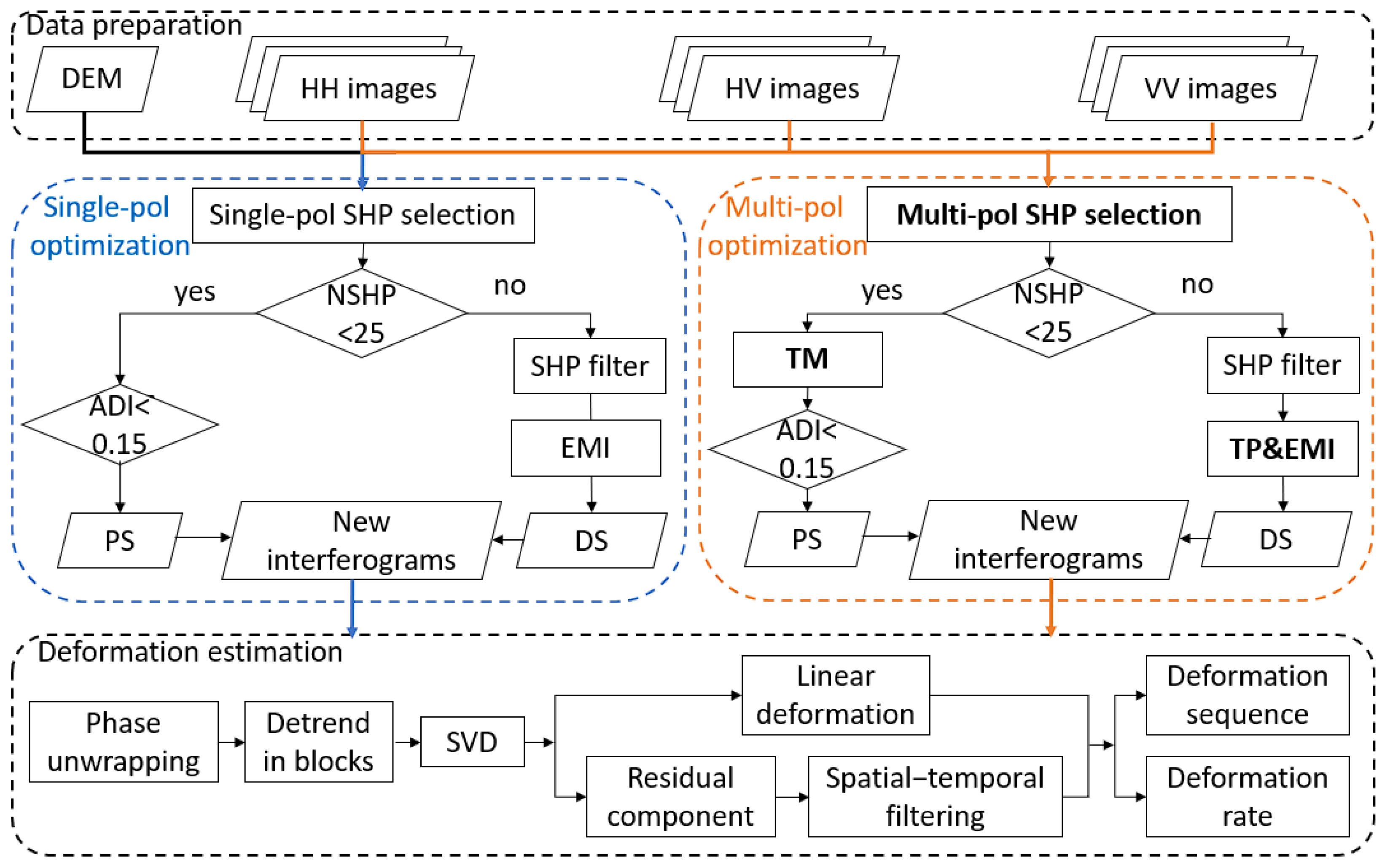
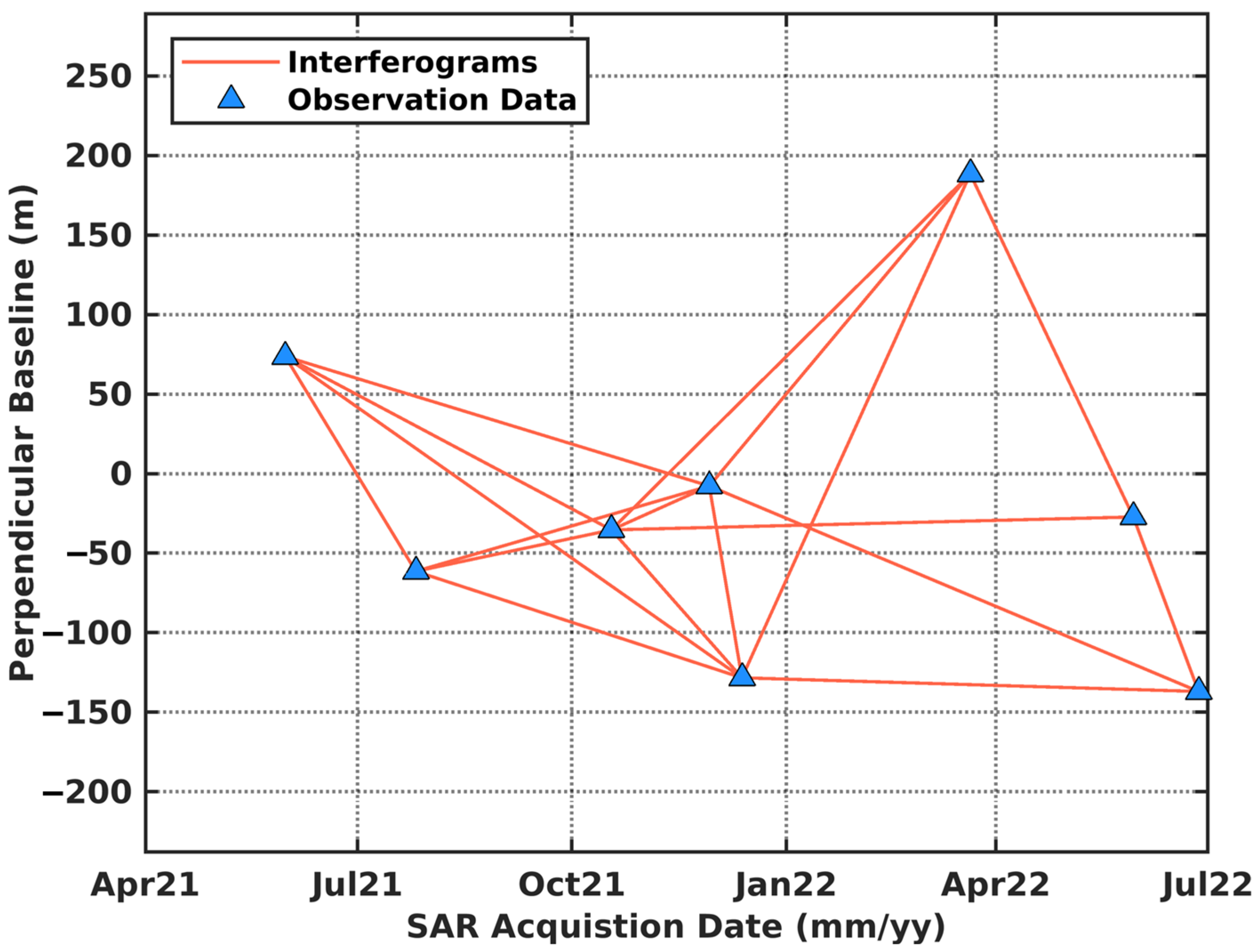

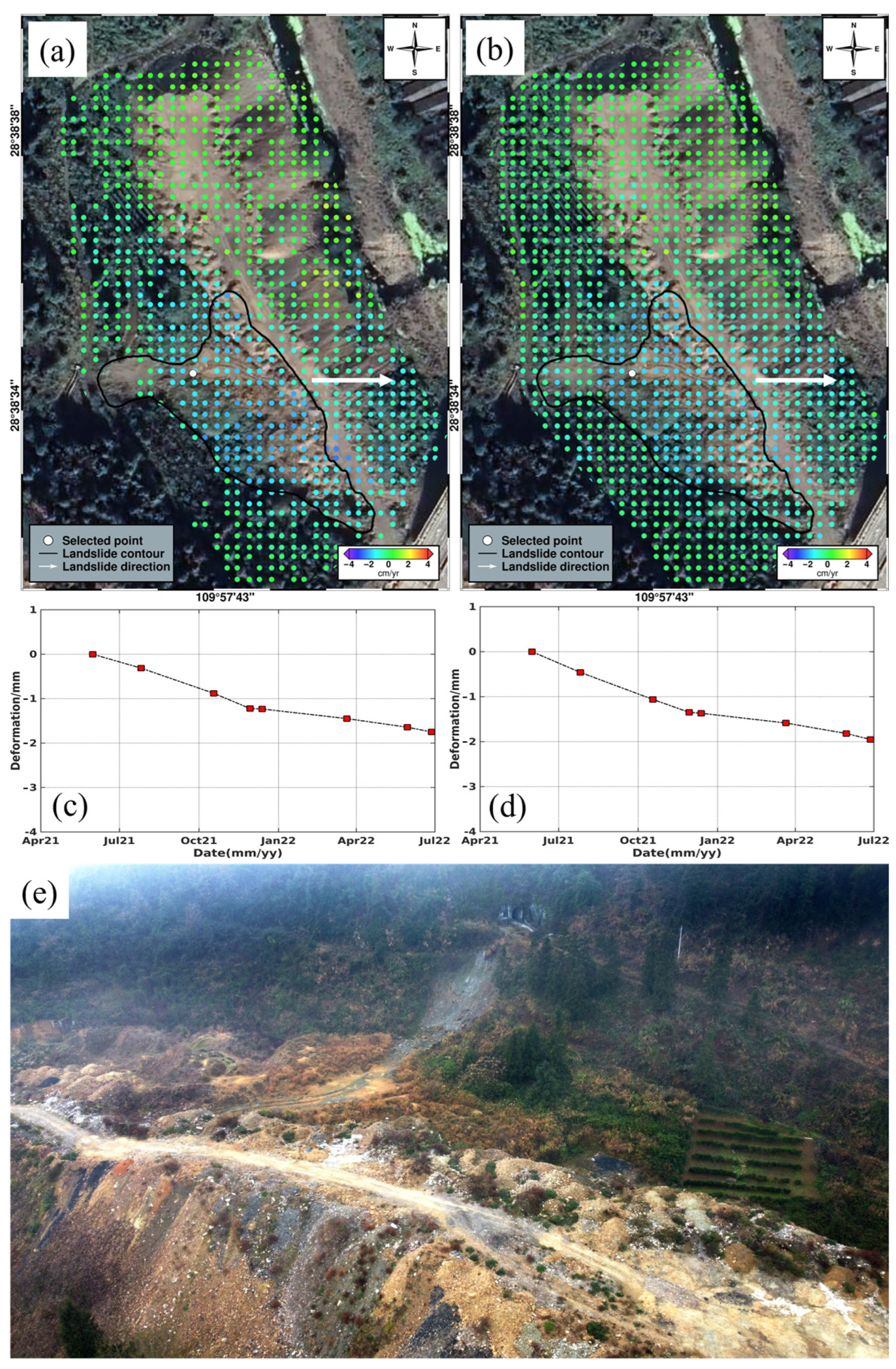

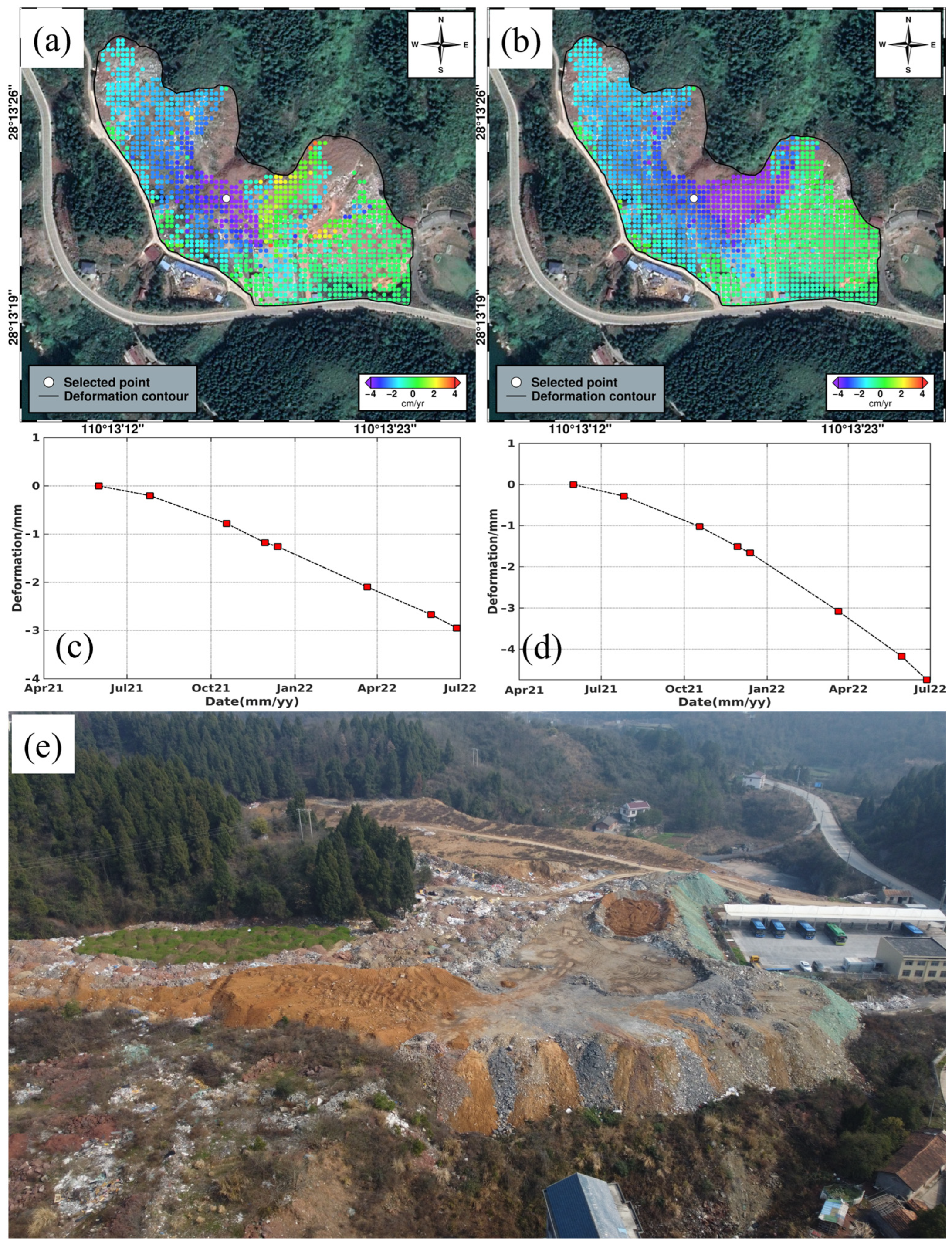
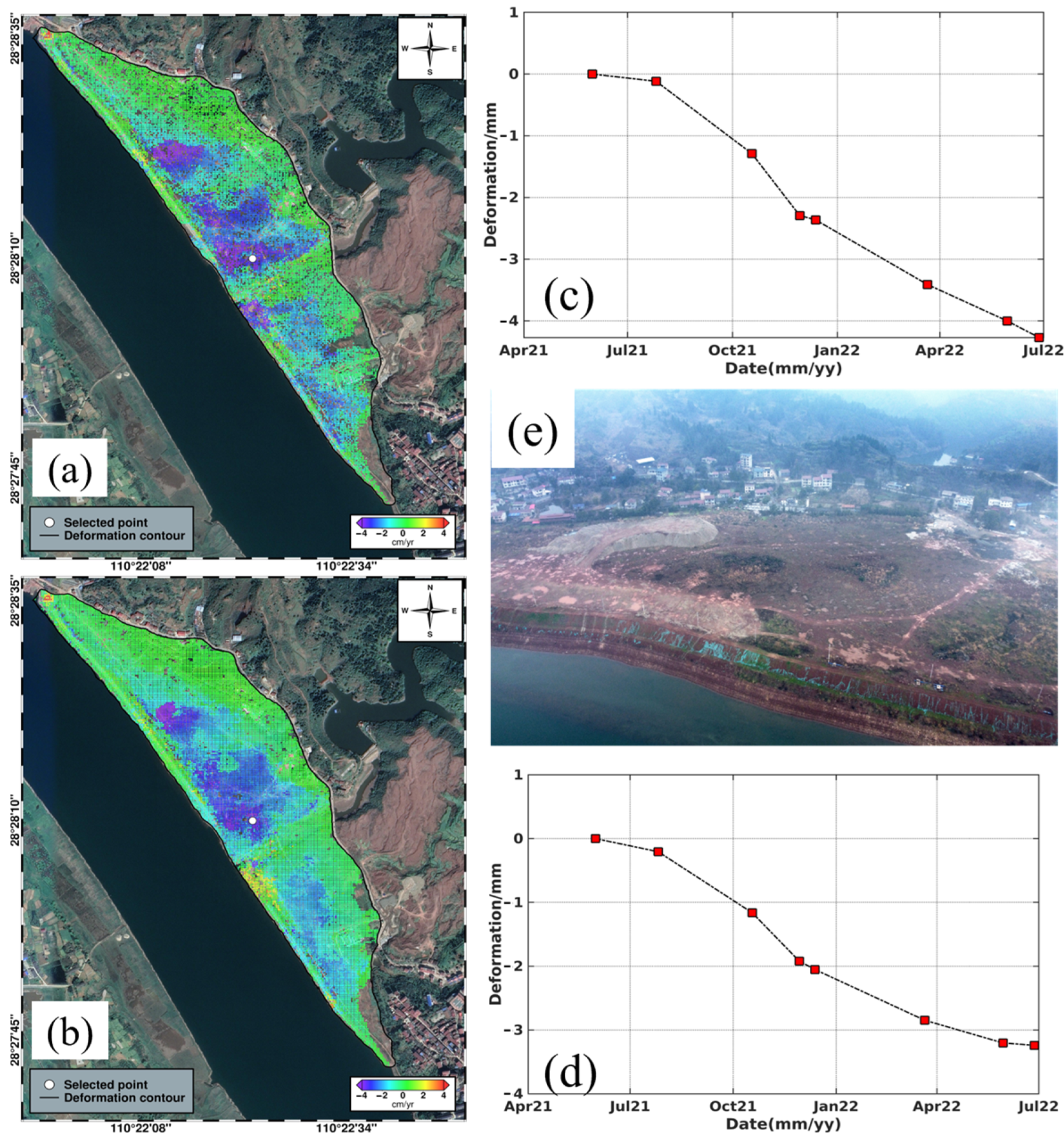

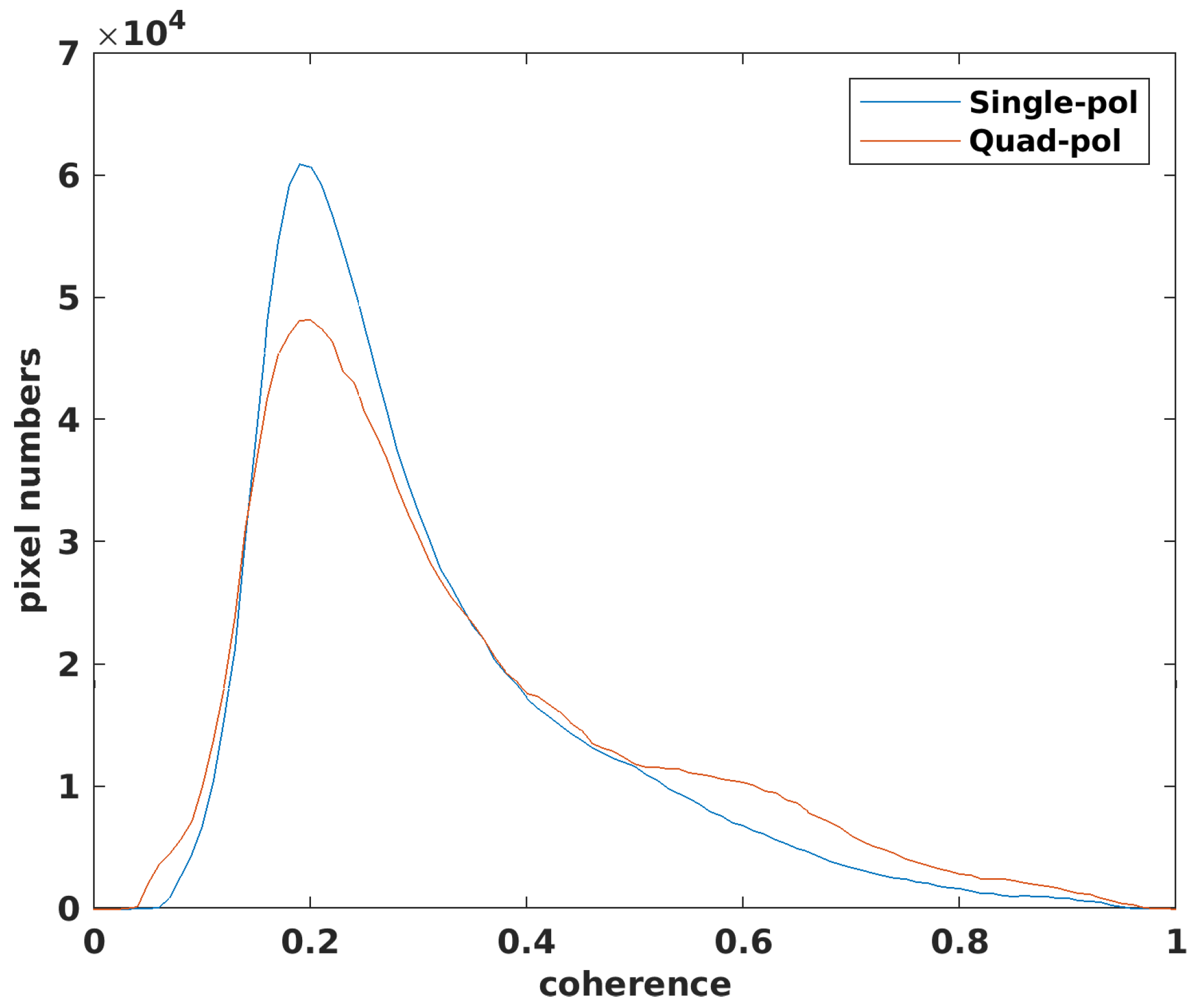
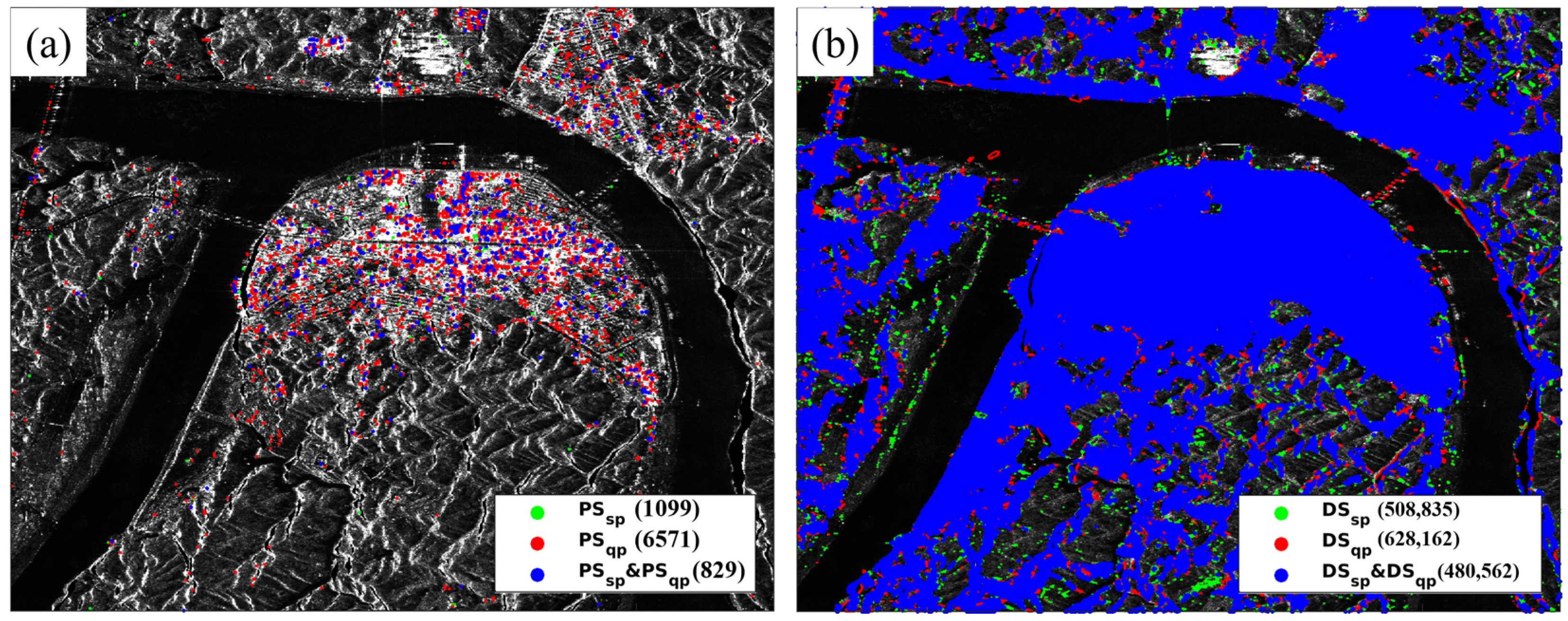
| Parameter | ALOS-2/PALSAR-2 |
|---|---|
| Flight Direction | Ascending orbit |
| Incidence Angle (°) | 27.8° |
| Polarization Mode | HH |
| Azimuth Sampling (m) | 5.3 |
| Range Sampling (m) | 6.1 |
| Wave (m) | 0.23 |
| Acquisition Period | 31 May 2021–27 June 2022 |
| ID | Longitude | Latitude | Type | Accuracy | Field Verification Findings |
|---|---|---|---|---|---|
| P01 | 110°24′34″ | 28°34′44″ | Landslide | Correct | Recorded geological hazard site without visible deformation |
| P02 | 110°19′52″ | 28°42′37″ | Landslide | Correct | Recorded geological hazard site with visible deformation |
| P03 | 110°20′55″ | 28°37′34″ | Subsidence | Correct | Erosion-induced deformation |
| P04 | 110°13′44″ | 28°28′23″ | Landslide | Incorrect | No clear deformation evidence |
| P05 | 109°55′0″ | 28°34′42″ | Landslide | Incorrect | No clear deformation evidence |
| P06 | 109°59′26″ | 28°38′25″ | Landslide | Incorrect | No clear deformation evidence |
| P07 | 110°3′ 53″ | 28°37′ 31″ | Landslide | Correct | Recorded geological hazard site without visible deformation |
| P08 | 109°57′30″ | 28°37′49″ | Landslide | Correct | Newly identified site with potential instability |
| P09 | 109°58′7″ | 28°25′46″ | Landslide | Correct | Recorded geological hazard site without visible deformation |
| P10 | 110°4′57″ | 28°31′22″ | Landslide | Correct | Recorded geological hazard site without visible deformation |
| P11 | 110°2′57″ | 28°34′57″ | Landslide | Incorrect | No clear deformation evidence |
| P12 | 110°3′12″ | 28°33′59″ | Landslide | Correct | Recorded geological hazard site with visible deformation |
| P13 | 110°7′50″ | 28°15′56″ | Landslide | Correct | Newly identified site with potential instability |
| P14 | 110°10′51″ | 28°10′50″ | Landslide | Correct | Newly identified site with potential instability |
| P15 | 110°13′14″ | 28°13′25″ | Subsidence | Correct | Surface deformation linked to waste accumulation |
| P16 | 110°22′19″ | 28°28′15″ | Subsidence | Correct | Surface deformation linked to engineering activities (e.g., soil transport) |
| P17 | 110°24′0″ | 28°26′03″ | Subsidence | Correct | Surface deformation linked to engineering activities (e.g., soil transport) |
| P18 | 110°12′ 15″ | 28°16′ 13″ | Landslide | Correct | Newly identified site with potential instability |
| P19 | 110°1′12″ | 28°33′46″ | Landslide | Correct | Recorded geological hazard site without visible deformation |
| P20 | 110°8′11″ | 28°33′13″ | Landslide | Correct | Recorded geological hazard site without visible deformation |
| P21 | 110°4′02″ | 28°9′54″ | Landslide | Correct | Newly identified landslide caused by quarrying activities |
| P22 | 110°24′19″ | 28°26′37″ | Subsidence | Correct | Surface deformation linked to local construction activities |
| P23 | 109°57′07″ | 28°19′51″ | Landslide | Correct | Recorded geological hazard site without visible deformation |
| P24 | 110°23′49″ | 28°29′35″ | Landslide | Correct | Recorded geological hazard site with visible deformation |
| P25 | 109°59′17″ | 28°34′57″ | Landslide | Incorrect | No clear deformation evidence |
| P26 | 109°59′11″ | 28°34′26″ | Landslide | Incorrect | No clear deformation evidence |
| P27 | 109°57′59″ | 28°38′39″ | Subsidence | Correct | Surface deformation linked to engineering activities (e.g., soil transport) |
| P28 | 109°57′59″ | 28°38′24″ | Subsidence | Correct | Surface deformation linked to engineering activities (e.g., soil transport) |
| P29 | 109°57′43″ | 28°38′35″ | Landslide | Correct | Newly identified hazard site with visible deformation |
| P30 | 110°5′01″ | 28°14′24″ | Subsidence | Correct | Surface deformation linked to agricultural activities |
| P31 | 110°3′22″ | 28°14′31″ | Landslide | Correct | Newly identified hazard site with visible slope deformation |
| P32 | 110°3′18″ | 28°13′48″ | Landslide | Correct | Newly identified landslide caused by quarrying activities |
Disclaimer/Publisher’s Note: The statements, opinions and data contained in all publications are solely those of the individual author(s) and contributor(s) and not of MDPI and/or the editor(s). MDPI and/or the editor(s) disclaim responsibility for any injury to people or property resulting from any ideas, methods, instructions or products referred to in the content. |
© 2025 by the authors. Licensee MDPI, Basel, Switzerland. This article is an open access article distributed under the terms and conditions of the Creative Commons Attribution (CC BY) license (https://creativecommons.org/licenses/by/4.0/).
Share and Cite
Liu, B.; Chen, Y.; Hu, J.; Yao, T.; Tan, Y.; Qin, Z.; Wang, C.; Yin, W. Landslide Identification in the Yuanjiang Basin of Northwestern Hunan, China, Using Multi-Temporal Polarimetric InSAR with Comparison to Single-Polarization Results. Remote Sens. 2025, 17, 1525. https://doi.org/10.3390/rs17091525
Liu B, Chen Y, Hu J, Yao T, Tan Y, Qin Z, Wang C, Yin W. Landslide Identification in the Yuanjiang Basin of Northwestern Hunan, China, Using Multi-Temporal Polarimetric InSAR with Comparison to Single-Polarization Results. Remote Sensing. 2025; 17(9):1525. https://doi.org/10.3390/rs17091525
Chicago/Turabian StyleLiu, Bo, Yaogang Chen, Jun Hu, Tengfei Yao, Yilun Tan, Zouhui Qin, Can Wang, and Wei Yin. 2025. "Landslide Identification in the Yuanjiang Basin of Northwestern Hunan, China, Using Multi-Temporal Polarimetric InSAR with Comparison to Single-Polarization Results" Remote Sensing 17, no. 9: 1525. https://doi.org/10.3390/rs17091525
APA StyleLiu, B., Chen, Y., Hu, J., Yao, T., Tan, Y., Qin, Z., Wang, C., & Yin, W. (2025). Landslide Identification in the Yuanjiang Basin of Northwestern Hunan, China, Using Multi-Temporal Polarimetric InSAR with Comparison to Single-Polarization Results. Remote Sensing, 17(9), 1525. https://doi.org/10.3390/rs17091525








